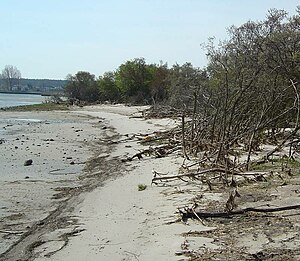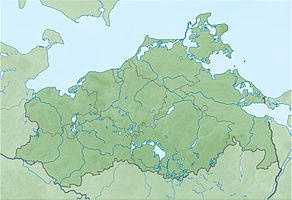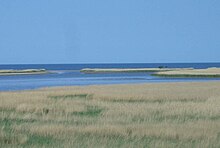Nature reserve Peenemünder Haken, Struck and Ruden
|
Nature reserve Peenemünder Haken, Struck and Ruden
|
||
|
East bank of the Struck peninsula |
||
| location | North of Wolgast in Vorpommern District Vorpommern-Greifswald | |
| surface | 7554 ha (1A) and 268 ha (1B) | |
| Identifier | 1A and 1B | |
| WDPA ID | 14343 (1A) and 378075 (1B) | |
| Geographical location | 54 ° 10 ' N , 13 ° 45' E | |
|
|
||
| Sea level | from -2 m to 10 m | |
| Setup date | March 30, 1925 (1A) and November 4, 1993 (1B) | |
| administration | LUNG | |
The nature reserve Peenemünder Haken, Struck and Ruden is a 7812 hectare nature reserve in Mecklenburg-Western Pomerania on both sides of the Peenestrom at the confluence with the Greifswalder Bodden . The nature reserve includes the northern part of the island of Usedom , the (half) island of Struck and the island of Ruden and their surroundings.
It was placed under protection on March 30, 1925 (part of the area with the identification 1A), extensions were made on November 4, 1993 and December 10, 2008 (part of the area identification 1B). Due to the essentially undisturbed development, the state of the area is good, although the state of the salt marshes as a resting place for Limikolen has deteriorated in recent years due to economic abandonment and predator pressure.
history
Intensive use of the area has been documented since the 14th century. The city of Wolgast used the Peenemünder forest . The salt marshes in the Peenemünder area were grazed, but their use was discontinued in 1936 when the Army Research Institute went into operation. The reed areas that were created were mowed regularly until 1985.
In the Freesendorfer Wiesen and Struck area , drainage ditches with subsequent pasture use can be identified since the 17th century. Drainage was intensified in 1983 by creating deep trenches. The areas were dyed in 1974/1975, cutting off the areas from the floods of the Greifswald Bodden . For the island of Ruden, the Swedish matriculation cards from 1694 occupy a land area that is twice as large. Especially the north bank of the Rudens was subject to erosion . Since 1877 a wall made of stone blocks has prevented further bank erosion.
Flora and fauna
Seagrass meadows can be found in the lagoon area from a water depth of two meters. In shallower areas growing pondweed , Strandsalde , zannichellia palustris and Chara . Due to strong currents, sediment transport and the formation of new land, the shallow water areas show considerable vegetation dynamics, were almost without vegetation from 1970 to 1980 and are now settled again. On the sand islands of the Peenemünde hook, reeds , beach ledges and Tartar lettuce grow . In the more protected areas, reeds with beach ledges and salt aster develop . To the south there are beach ridges with alder trees in moored areas and old oak and beech stocks. On the (half) island of Struck there are grazed salt marshes. Birch-oak forest grows on the higher beach ridges on the island . Pre-forest-like sea buckthorn stands grow on the alluvial areas of the Spandowerhagener Wiek . The Ruden is planted with a planted dune pine forest .
120 breeding bird species and 250 guest bird species have been recorded in the area. Strong stocks form cormorant , mute swan , white-fronted goose , gray goose , widgeon , teal , mallard , scaup , long-tailed duck and Blässralle . The area is an important resting place for water birds. The breeding success of meadow breeders such as the lapwing , dunlin and redshank has declined sharply in recent decades due to predators such as fox , raccoon dog and wild boar . The last occurrences of the reed warbler in the country were found on the flushing areas . There is evidence of otters in the Freesendorfer See area . Gray seals are occasionally sighted.
The shallow water areas form the habitat of numerous species of fish such as pike , herring , flounder , eel , garfish and pikeperch .
literature
- Environment Ministry Mecklenburg-Western Pomerania (Ed.): Peenemünder Haken, Struck and Ruden 1 in: The nature reserves in Mecklenburg-Western Pomerania . Demmler-Verlag, Schwerin 2003, p. 160 f.
Web links
- Nature reserve ordinance
- Map portal Umwelt MV with geodata (protected area border, results of biotope mapping, etc.)
- Photos from the nature reserve
- Protected area management Greifswalder Bodden
- Voluntary agreement for driving and fishing (pdf) ( Memento from January 3, 2006 in the Internet Archive ) (88 kB)





